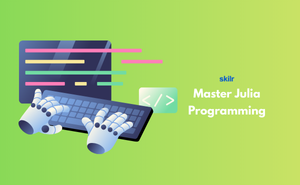👇 CELEBRATE CLOUD SECURITY DAY 👇
00
HOURS
00
MINUTES
00
SECONDS

The Julia language is a powerful tool that brings together the ease of scripting with the efficiency of low-level programming. It is designed for speed, scalability, and handling advanced numerical and data operations. Julia is especially useful in areas where performance and accuracy are critical, such as machine learning, simulations, and computational research.
By mastering Julia, candidates can solve complex problems faster and more efficiently. It allows them to write clear, concise code while leveraging its ability to handle demanding workloads. Julia’s growing role in both industry and academia makes it an excellent choice for those looking to strengthen their technical skills.
This exam is ideal for:
Domain 1 - Introduction to Julia
Domain 2 - Basic Syntax and Programming Concepts
Domain 3 - Data Structures in Julia
Domain 4 - Functions and Modules
Domain 5 - Working with Data
Domain 6 - Mathematical and Statistical Computing
Domain 7 - Performance Optimization
Domain 8 - Julia for Data Science and AI
Domain 9 - Advanced Applications
Industry-endorsed certificates to strengthen your career profile.
Start learning immediately with digital materials, no delays.
Practice until you’re fully confident, at no additional charge.
Study anytime, anywhere, on laptop, tablet, or smartphone.
Courses and practice exams developed by qualified professionals.
Support available round the clock whenever you need help.
Easy-to-follow content with practice exams and assessments.
Join a global community of professionals advancing their skills.
Yes, it has libraries for ML, deep learning, and data processing.
While not required, having some math knowledge helps in advanced applications.
Julia is faster for numerical and data-heavy tasks, though Python has a larger ecosystem.
Yes, its syntax is simple, making it suitable for newcomers.
Julia is mainly used for scientific computing, data science, AI, and high-performance applications.
Julia is rapidly growing and is expected to be a leading tool in scientific and AI fields.
Data scientist, AI engineer, researcher, and computational modeler.
Yes, many researchers use it for simulations and mathematical modeling.
Yes, it’s optimized for handling large datasets efficiently.
It positions candidates for advanced roles in data-driven and scientific industries.
Julia approaches C-level speed while being easier to write.
While possible, it’s mainly designed for scientific and data applications.
Yes, it’s free and open-source.
Finance, research, healthcare, artificial intelligence, and engineering.
Yes, it can interface with Python, C, and R.